
- 7 Nights / 8 Days
- 3 star/4 star
- Airconditioned Vehicle
- Fast Pace
- Private Tour
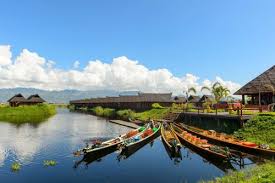
- 10 Nights / 11 Days
- 3 star/4 star
- Airconditioned Vehicle
- Fast Pace
- Private Tour
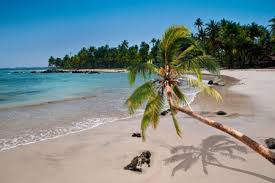
- 14 Nights / 15 Days
- 3 star/4 star
- Airconditioned Vehicle
- Moderate Pace
- Private Tour

- 15 Nights / 16 Days
- 3 star/4 star
- Airconditioned Vehicle
- Fast Pace
- Private Tour
Myanmar remains one of the most majestic and spiritual destinations in Asia filled with temples, history, culture, beautiful scenery and authentic cuisine.
Also known as Burma, this remarkable country is bordered by China, Thailand, India, Laos and Bangladesh. Early civilization in Myanmar dates back to the 5th century and reached its peak of power and creativity between the 11th and 15th century. Myanmar is a unique destination that has stood still in time, untouched by the modern world.
Arrive in Yangon and explore the country’s capital city which offers British colonial architecture, tea houses and shady parks. Be amazed by the sacred Shwedagon Pagoda with its giant stupa and the sacred Sule pagoda that is visible from many angles of the city. Yangon may not be your cosmopolitan Asian city however is surely becoming a hot spot in Asia.
The UNESCO-listed Bagan is a must see! It boasts over 2,000 ancient temples, pagodas and monasteries. If budget permits, a hot air balloon ride over Bagan is a memorable way to get a bird’s eye view of the amazing stupas. Another highlight is watching the breathtaking sunsets sitting over a stupa or by the Irrawaddy river. Whether you are a novice traveller or a travel Connoisseur, you will surely to be impressed by the sheer size and the architectural masterpieces of this ancient and breathtaking archaeological site.
Mandalay, a former royal capital filled with culture and art is another key place to visit. Explore the Kuthodaw Pagoda where the world’s largest book is housed. Visit the iconic U-bein bridge, which is the longest teak bridge in the world, hosting one of the most amazing sunsets. If you want to experience serenity and peace, visit the Mahagandaryone monastery during the alms giving where you may observe hundreds of monks walk down the street to accept the food offerings.
Cruise Inle lake, set in the Shan hills to enjoy floating villages, gardens, monasteries and the iconic one leg-rowing Intha fishermen. It is certainly a unique experience to remember. There are many resorts located along the lake side allowing you to soak in the serenity and watch the day goes by.
If you are into trekking, Myanmar is one of the best places for the adventure seekers. Kalaw, near the Inle lake is one of the key spots to embrace the nature whilst hiking. You will trek through the many plateaus, fruit trees and hill tribes whilst enjoying the unique and authentic Burmese cuisine prepared by the locals.
Why not complete your tour by spending time at the untouched and unspoilt Ngapali beach. It is not your typical touristy beach but rather a place to fully relax. This stunning beach is surrounded by 7 km of white powdery sand, fringed with towering palm trees.
In addition to the amazing temples, architecture and landscapes, Myanmar’s true treasure is the genuine and welcoming smiles of the locals. You will feel the warmth and true hospitality of the locals which makes Myanmar a memorable destination.
For all the food lovers, there is always something new and unique to try. Burmese cuisine has been influenced by Indian, Chinese and Thai cuisines as well as domestic ethnic cuisines. It is not widely known throughout the world and can be characterised as having a mildly spicy taste, with a limited use of spices. A typical Burmese meal consists of several meat curries, a soup, steamed rice and fermented sauce of preserved fish, along with vegetables for dipping.
Explore this land untouched by mass tourism and embrace the culture and serenity that will take your breath way. Visit Myanmar and re-connect with the rare nature and serenity.
YANGON REGION
-
Shwedagon Pagoda (Yangon)
 Shwedagon Pagoda is considered one of the most religious Pagodas in the world for Buddhists. It is a respected monument reflecting the national heritage, architecture, sculpture and arts of Myanmar, that spans an era of almost 2,500 years. Nearing 100 m tall, it is believed that the pagoda enshrines a sacred relic of Buddha. This elaborately decorated Buddhist monument is covered with gold plates and top of the stupa is encrusted with diamonds. Lit up at night with colourful stupas and statues, it is truly a sight to see.
Shwedagon Pagoda is considered one of the most religious Pagodas in the world for Buddhists. It is a respected monument reflecting the national heritage, architecture, sculpture and arts of Myanmar, that spans an era of almost 2,500 years. Nearing 100 m tall, it is believed that the pagoda enshrines a sacred relic of Buddha. This elaborately decorated Buddhist monument is covered with gold plates and top of the stupa is encrusted with diamonds. Lit up at night with colourful stupas and statues, it is truly a sight to see. -
Sule Pagoda (Yangon)
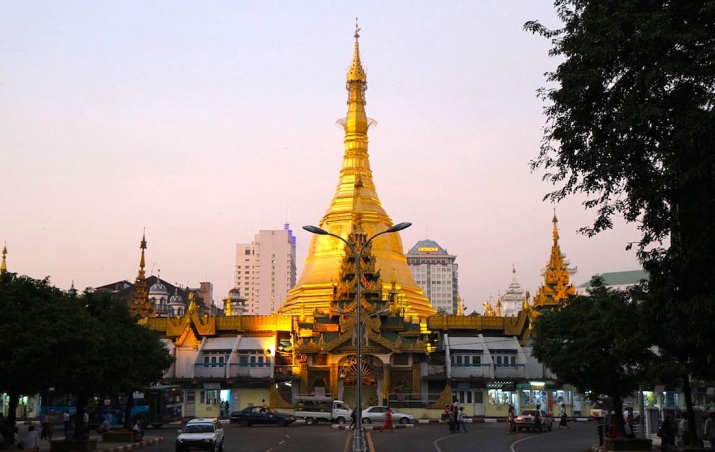 Built during the lifetime of Buddha, Sule pagoda is about 2,500 years old according to the legend. It is said to enshrine a hair relic of the Gautama Buddha which was gifted to two Burmese merchant brothers. The pagoda was much smaller at the time of built but has been renovated and extended by later Kings. The paya reached its present height when it was renovated halfway in the 15th century. Throughout history, many have used the pagoda for different purposes. The British utilised it as the centre of town planning during the colonial era. The Burmese Royalty used it as a meeting point and it was used in the recent past as a gathering point by the activists of the 1988 uprising and the Saffron Revolution in 2007. The pagoda is a good starting point for exploring the city of Yangon, as it is conveniently located adjacent to the Mahabandoola Park.
Built during the lifetime of Buddha, Sule pagoda is about 2,500 years old according to the legend. It is said to enshrine a hair relic of the Gautama Buddha which was gifted to two Burmese merchant brothers. The pagoda was much smaller at the time of built but has been renovated and extended by later Kings. The paya reached its present height when it was renovated halfway in the 15th century. Throughout history, many have used the pagoda for different purposes. The British utilised it as the centre of town planning during the colonial era. The Burmese Royalty used it as a meeting point and it was used in the recent past as a gathering point by the activists of the 1988 uprising and the Saffron Revolution in 2007. The pagoda is a good starting point for exploring the city of Yangon, as it is conveniently located adjacent to the Mahabandoola Park. -
Colonial Buildings (Yangon)
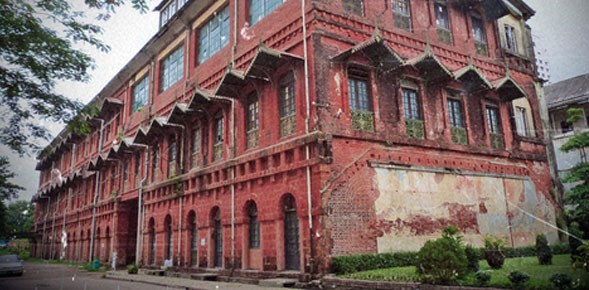 Yangon has a rich British history influence and is one of the finest places for viewing colonial architecture. Myanmar became a colony of Britain in 1824 after the First Anglo-Burmese War, and remained a colony of Britain until 1948. Step back into the colonial era and explore these outstanding pieces of architecture. Some of the highlights include the Secretariat building, high court, Strand Hotel, Bogyoke Aung San Market, Governor’s Residence and Police Commissioner’s Building.
Yangon has a rich British history influence and is one of the finest places for viewing colonial architecture. Myanmar became a colony of Britain in 1824 after the First Anglo-Burmese War, and remained a colony of Britain until 1948. Step back into the colonial era and explore these outstanding pieces of architecture. Some of the highlights include the Secretariat building, high court, Strand Hotel, Bogyoke Aung San Market, Governor’s Residence and Police Commissioner’s Building. -
Bogyoke Aung San Market (Yangon)
 The popular Bogyoke Aung San Market is situated in the heart of Yangon on Bogyoke Aung San Road in an impressive colonial building. The market was first built and inaugurated on the present premises in 1926. It was originally named Scott Market after Mr. C. Scott, the Municipal Commissioner. However, its name was changed to Bogyoke Aung San Market in honour of the national leader, General Aung San who was assassinated in 1947. Shoppers can spend their time browsing hundreds of shops that sell items such as handicrafts, food items, clothing, jewellery, fashion and more.
The popular Bogyoke Aung San Market is situated in the heart of Yangon on Bogyoke Aung San Road in an impressive colonial building. The market was first built and inaugurated on the present premises in 1926. It was originally named Scott Market after Mr. C. Scott, the Municipal Commissioner. However, its name was changed to Bogyoke Aung San Market in honour of the national leader, General Aung San who was assassinated in 1947. Shoppers can spend their time browsing hundreds of shops that sell items such as handicrafts, food items, clothing, jewellery, fashion and more. -
Chauk Htat Gyi Pagoda (Yangon)
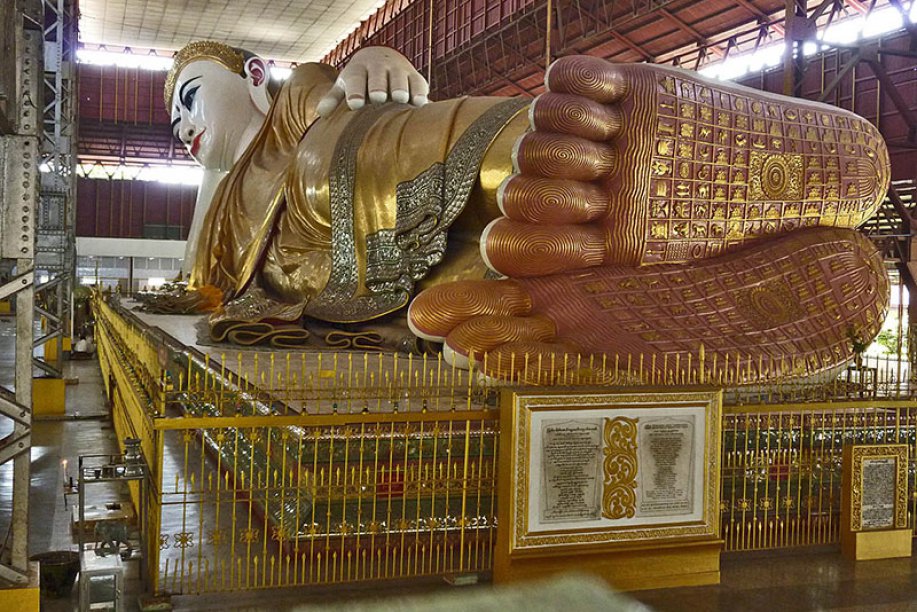 Chauk Htat Gyi Pagoda is an exquisite sight to see. It’s breathtaking beauty of Buddhist architecture and the iconic giant reclining Buddha is considered one of the greatest in South East Asia. The Reclining Buddha statue was originally built in 1907 by Sir Hpo Thar. Due to damage occurred, it was rebuilt to its current structure in 1966, purely based on donations received. It boasts a solid architecture, covered by an iron structure with a corrugated iron sheet roof of six layers. Therefore, earning its general name as “the six-tiered pagoda”.
Chauk Htat Gyi Pagoda is an exquisite sight to see. It’s breathtaking beauty of Buddhist architecture and the iconic giant reclining Buddha is considered one of the greatest in South East Asia. The Reclining Buddha statue was originally built in 1907 by Sir Hpo Thar. Due to damage occurred, it was rebuilt to its current structure in 1966, purely based on donations received. It boasts a solid architecture, covered by an iron structure with a corrugated iron sheet roof of six layers. Therefore, earning its general name as “the six-tiered pagoda”. -
Kandawgyi Nature Park & Karaweik Palace (Yangon)
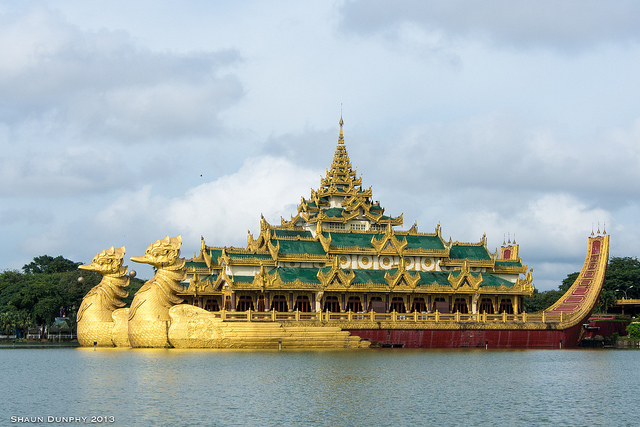 Kandawgyi Park (also known as Kandawgyi Nature Park OR Kandawgyi Garden) is a popular destination for recreation in the capital of Yangon. Kandawgyi Lake surrounded by the park is an extraordinary site to see at sunset as the golden lights of the Shwedagon Pagoda glistens in its calm water. The boardwalk, which runs mainly along the southern and western sides of the lake is an ideal place for an early-morning jog or stroll. The picnic areas and playgrounds under the shady trees are especially popular with families. Spread over a vast 260 acres you can also find tropical gardens, restaurants and recreation centers, a big walkway along the Lake, a mini zoo and views of the Shwedagon Pagoda and Karaweik Hall.
Kandawgyi Park (also known as Kandawgyi Nature Park OR Kandawgyi Garden) is a popular destination for recreation in the capital of Yangon. Kandawgyi Lake surrounded by the park is an extraordinary site to see at sunset as the golden lights of the Shwedagon Pagoda glistens in its calm water. The boardwalk, which runs mainly along the southern and western sides of the lake is an ideal place for an early-morning jog or stroll. The picnic areas and playgrounds under the shady trees are especially popular with families. Spread over a vast 260 acres you can also find tropical gardens, restaurants and recreation centers, a big walkway along the Lake, a mini zoo and views of the Shwedagon Pagoda and Karaweik Hall. -
China Town (Yangon)
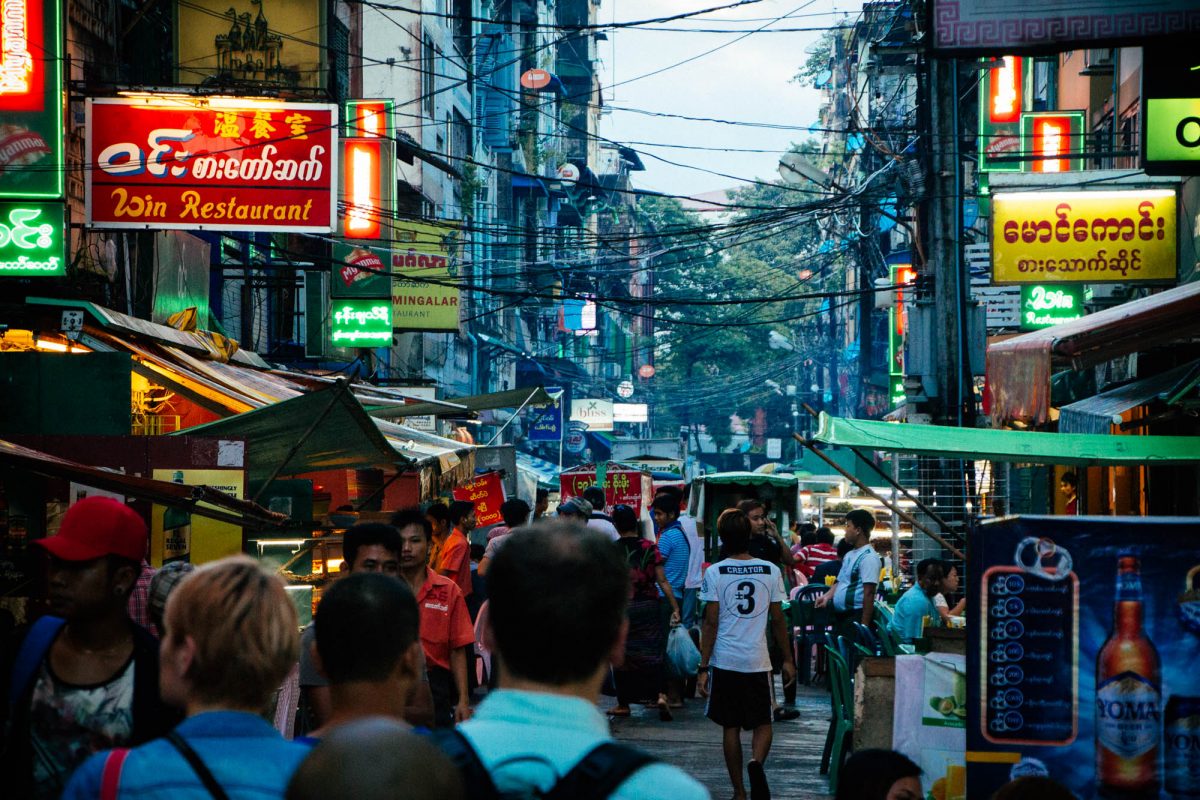 The popular China Town is located on 19th Street in Yangon city. There aren’t any street signs to follow but it is quite popular and easy to find. It is renowned for its long rows of mouth-watering barbecue stalls. Enjoy freshly made skewers tossed on the fire pit and menus packed with local sensations. This foodie street comes to life at night filled with food stalls, restaurants and simple eateries. This is also the place to be if you are looking for cheap beer and a friendly chit chat with the hospitable locals. Don’t forget to taste a nice chilled glass of local Myanmar beer while there!
The popular China Town is located on 19th Street in Yangon city. There aren’t any street signs to follow but it is quite popular and easy to find. It is renowned for its long rows of mouth-watering barbecue stalls. Enjoy freshly made skewers tossed on the fire pit and menus packed with local sensations. This foodie street comes to life at night filled with food stalls, restaurants and simple eateries. This is also the place to be if you are looking for cheap beer and a friendly chit chat with the hospitable locals. Don’t forget to taste a nice chilled glass of local Myanmar beer while there!
MANDALAY REGION
-
Nyaung U Market (Bagan)
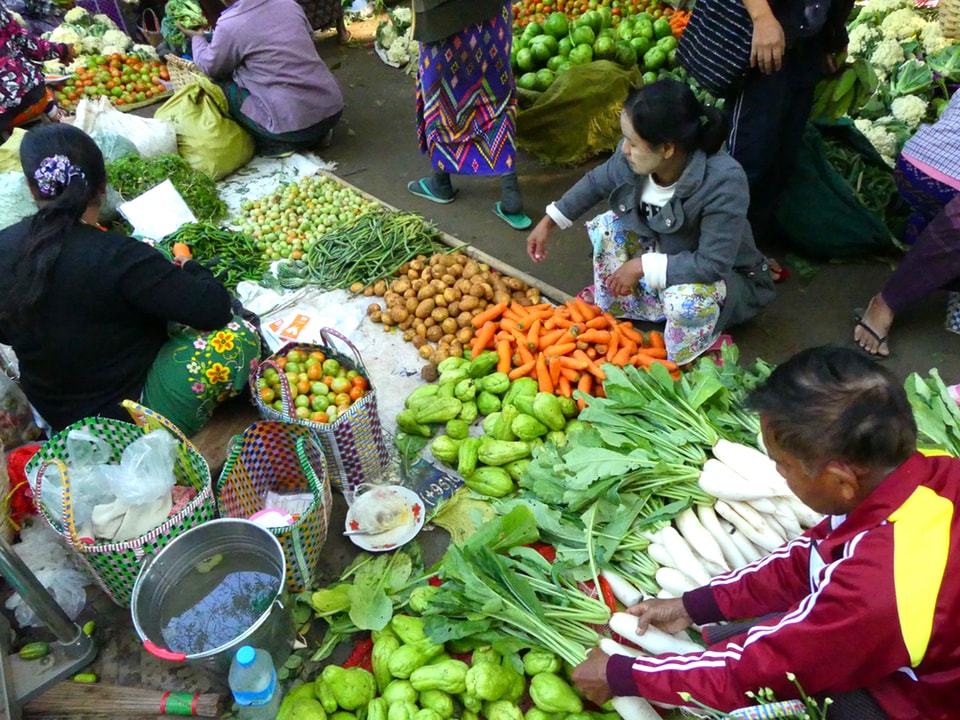 The sleepy town of Nyaung U is located 4km away from old Bagan. The vibrant Nyaung U Market is the main highlight, allowing visitors the opportunity to interact with the locals and learn about their daily lifestyle. The market offers a variety of items with unique experiences at every corner. Be amazed by how crafters turn a block of ordinary wood into a masterpiece, smell the scent of local fragrant rice, encounter friendly locals with yellow face powder (local sunblock "thankaka") on their cheeks and learn where the thankaka comes from. You can also observe nuns collecting alms from local residents.
The sleepy town of Nyaung U is located 4km away from old Bagan. The vibrant Nyaung U Market is the main highlight, allowing visitors the opportunity to interact with the locals and learn about their daily lifestyle. The market offers a variety of items with unique experiences at every corner. Be amazed by how crafters turn a block of ordinary wood into a masterpiece, smell the scent of local fragrant rice, encounter friendly locals with yellow face powder (local sunblock "thankaka") on their cheeks and learn where the thankaka comes from. You can also observe nuns collecting alms from local residents. -
Bagan Temples (Bagan)
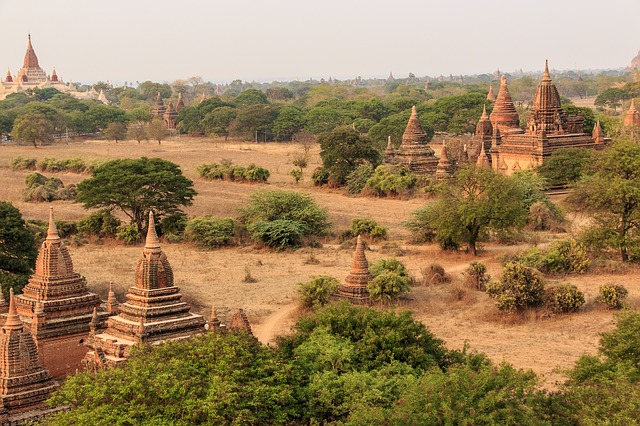 The Temples of Bagan are one of the most popular and must visit destinations in Myanmar. Majority of these majestic and ancient temples were constructed between the 11th and 13th centuries, during the prosperous Kingdom of Pagan. In this era over 10,000 Buddhist temples, pagodas and monasteries were built within the Bagan plains. In the modern times, only around 2,200 of these remarkable structures have remained intact. Bagan temples, pagodas and monasteries are spread over a large geographical area and are often compared to the Angkor Wat in Cambodia, in order to comprehend its size. There are various means of exploring the main highlights of Bagan temples. If budget allows, taking a hot air balloon ride over the temples will provide you with spectacular bird’s eye view. There are also opportunities to enjoy breathtaking sunsets and take home a snapshot of the magnificent structures and views.
The Temples of Bagan are one of the most popular and must visit destinations in Myanmar. Majority of these majestic and ancient temples were constructed between the 11th and 13th centuries, during the prosperous Kingdom of Pagan. In this era over 10,000 Buddhist temples, pagodas and monasteries were built within the Bagan plains. In the modern times, only around 2,200 of these remarkable structures have remained intact. Bagan temples, pagodas and monasteries are spread over a large geographical area and are often compared to the Angkor Wat in Cambodia, in order to comprehend its size. There are various means of exploring the main highlights of Bagan temples. If budget allows, taking a hot air balloon ride over the temples will provide you with spectacular bird’s eye view. There are also opportunities to enjoy breathtaking sunsets and take home a snapshot of the magnificent structures and views. -
Mount Popa (1 hour from Bagan)
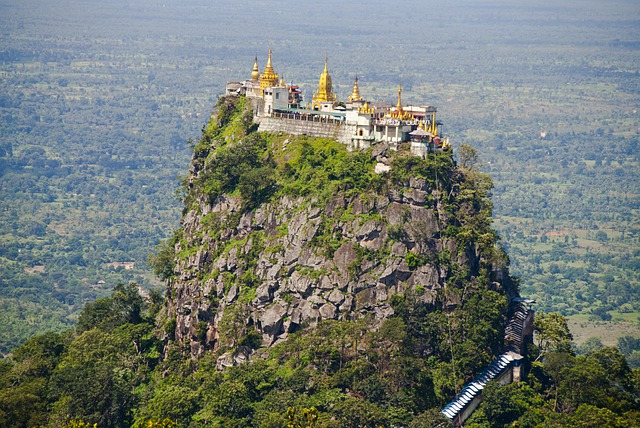 Mount Popa is located an hour’s drive from Bagan. The mountain rises 1500 metres above sea-level and to reach the summit there are nearly 800 steps to climb. It is generally a comfortable climb which is mostly shaded and offer magnificent views of the surrounding area. Mount Popa is an evergreen oasis situated amongst an arid zone. Volcanic ash has fertilized the mountain and produced an excessive growth of lush vegetation. The Burmese people also believe that people who climb Mount Popa should not wear red or black, or swear or speak ill of others. As a sign of respect, they also advise against bringing meat (especially pork), to avoid offending the Nats who may cast a spell on them.
Mount Popa is located an hour’s drive from Bagan. The mountain rises 1500 metres above sea-level and to reach the summit there are nearly 800 steps to climb. It is generally a comfortable climb which is mostly shaded and offer magnificent views of the surrounding area. Mount Popa is an evergreen oasis situated amongst an arid zone. Volcanic ash has fertilized the mountain and produced an excessive growth of lush vegetation. The Burmese people also believe that people who climb Mount Popa should not wear red or black, or swear or speak ill of others. As a sign of respect, they also advise against bringing meat (especially pork), to avoid offending the Nats who may cast a spell on them. -
Shwe Nan Daw Kyaung Monastery (Mandalay)
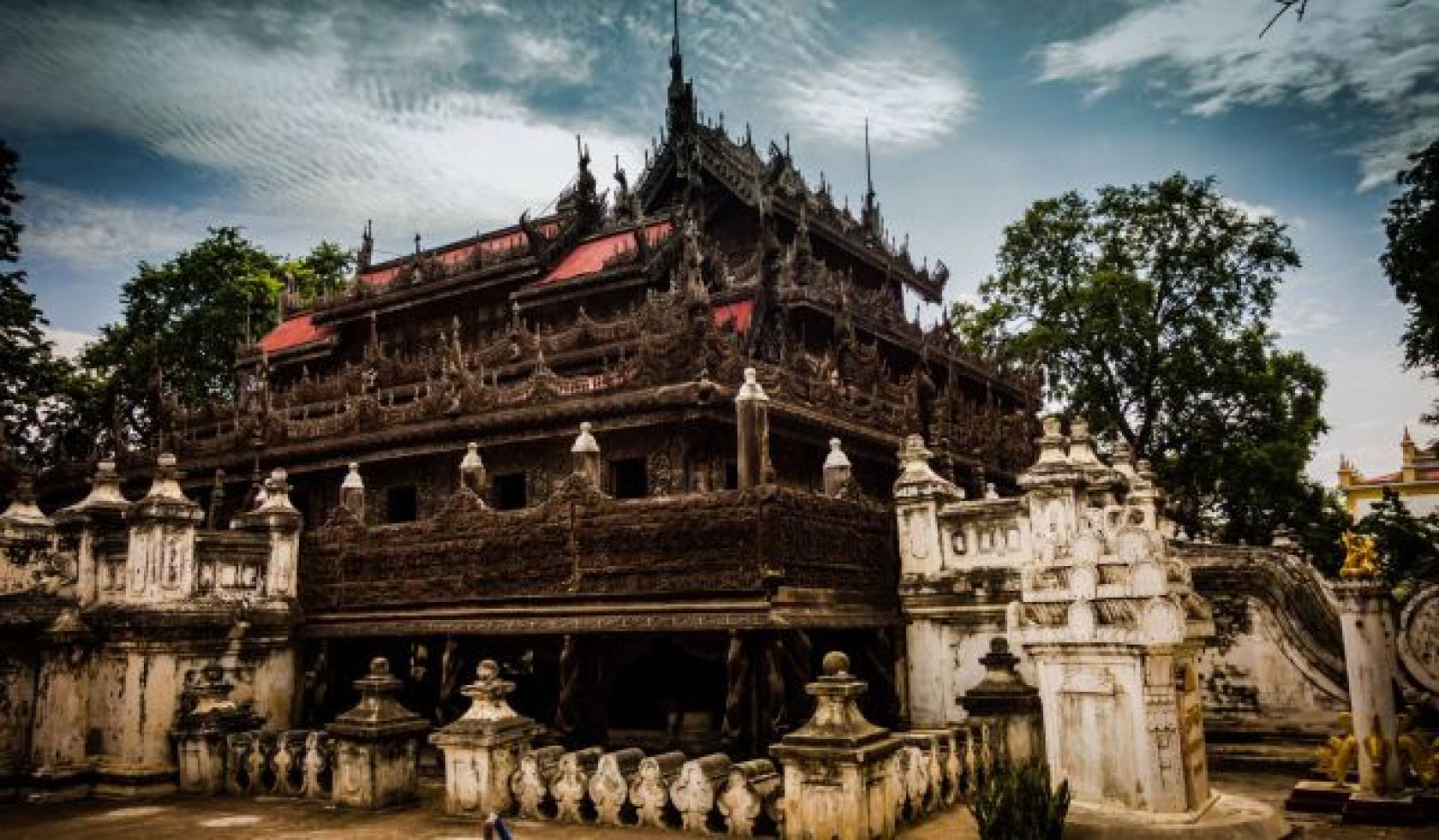 The Shwenandaw Monastery is also known as the Golden Palace. It is one of the most historic buildings of Mandalay, built in the 1800s by King Mindon. The Shwenandaw Monastery was originally part of the royal palace in Amarapura, before being moved to Mandalay forming the northern section of the Hmannan (Glass Palace) and is also filled with mosaic glass work. The Monastery’s history and antique uniqueness draws many to this site. It is marvelously constructed entirely of teak wood reflecting the valuable wooden architecture of Myanmar.
The Shwenandaw Monastery is also known as the Golden Palace. It is one of the most historic buildings of Mandalay, built in the 1800s by King Mindon. The Shwenandaw Monastery was originally part of the royal palace in Amarapura, before being moved to Mandalay forming the northern section of the Hmannan (Glass Palace) and is also filled with mosaic glass work. The Monastery’s history and antique uniqueness draws many to this site. It is marvelously constructed entirely of teak wood reflecting the valuable wooden architecture of Myanmar. -
Kuthodaw Pagoda (Mandalay)
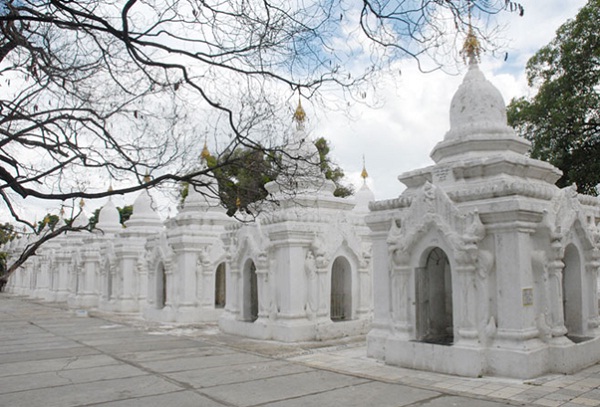 Located at the foothills of Mandalay Hill, Kuthadow Pagoda was built during the reign of King Mindon Min in the 1850’s. King was motivated by his concern that the valuable teachings of Gautama Buddha may be lost during the British settlement. King Mindon was determined to preserve the entire text of the Tipitaka Pali Canon of Theravada Buddhism, by inscribing them on large marble slabs. There are a total of 730 slabs. Each stone tablet is housed in its own shrine, called kyauksa gu, with a precious gem on top, and they are arranged around the central golden pagoda. These 730 slabs of marble are figuratively also called the “world's largest book.”
Located at the foothills of Mandalay Hill, Kuthadow Pagoda was built during the reign of King Mindon Min in the 1850’s. King was motivated by his concern that the valuable teachings of Gautama Buddha may be lost during the British settlement. King Mindon was determined to preserve the entire text of the Tipitaka Pali Canon of Theravada Buddhism, by inscribing them on large marble slabs. There are a total of 730 slabs. Each stone tablet is housed in its own shrine, called kyauksa gu, with a precious gem on top, and they are arranged around the central golden pagoda. These 730 slabs of marble are figuratively also called the “world's largest book.” -
Mandalay Hill (Mandalay)
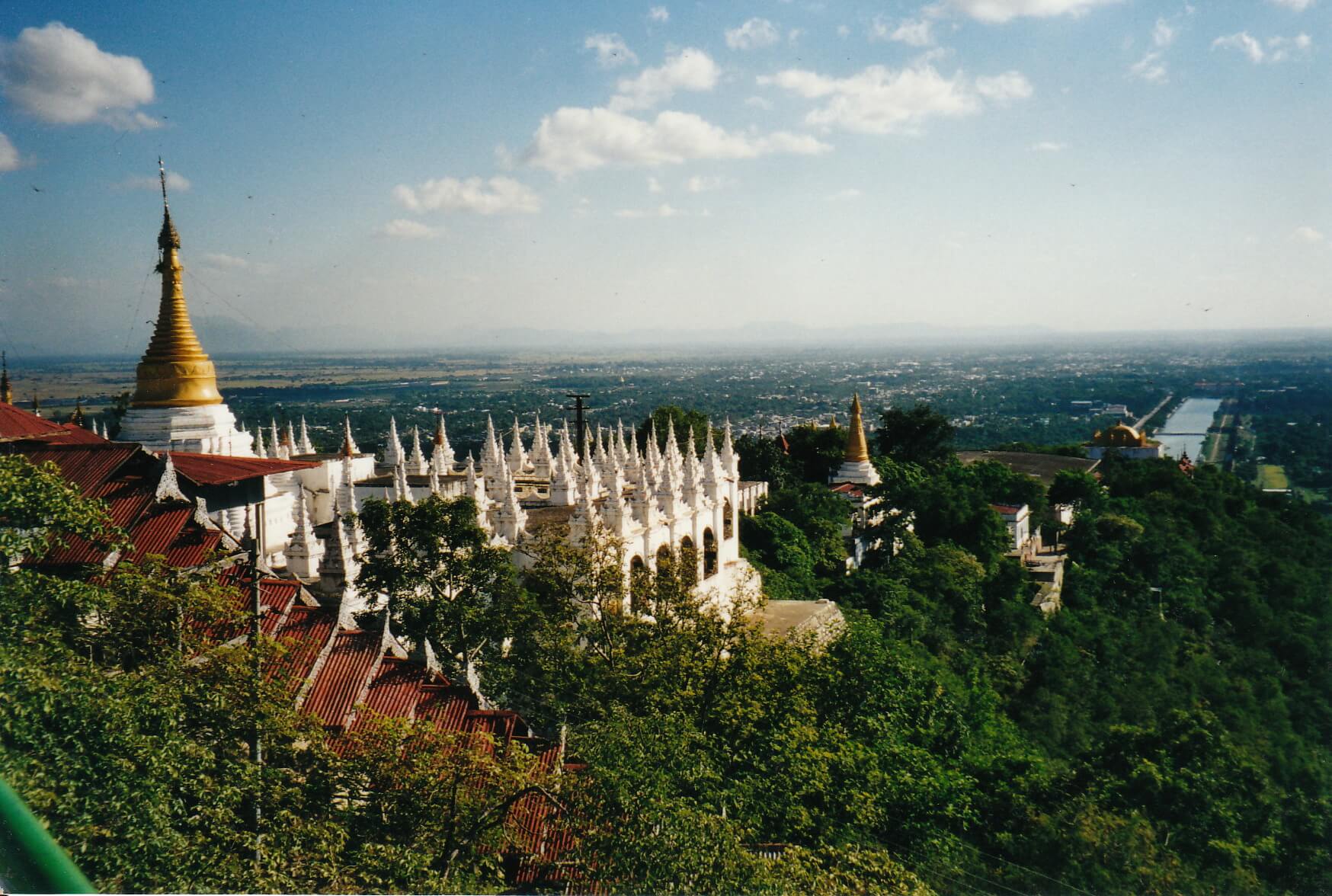 Mandalay Hill is famously known for its spectacular summit views and stunning sunsets. Many Buddhists take pilgrimages here, as it is believed that Lord Buddha visited Mandalay Hill and prophesied that a great city would be built at its foot. The climb up the staircase has 2 different routes (an easier and another a more difficult climb) and offers many interesting stops including temples, shrines and souvenir stalls run by locals. Regardless of which option you take, be rewarded by breathtaking views of the city and surrounding landscapes.
Mandalay Hill is famously known for its spectacular summit views and stunning sunsets. Many Buddhists take pilgrimages here, as it is believed that Lord Buddha visited Mandalay Hill and prophesied that a great city would be built at its foot. The climb up the staircase has 2 different routes (an easier and another a more difficult climb) and offers many interesting stops including temples, shrines and souvenir stalls run by locals. Regardless of which option you take, be rewarded by breathtaking views of the city and surrounding landscapes. -
Mahamuni Pagoda (Mandalay)
 The Mahamuni temple in Mandalay is classified as one the three most important religious sites in Myanmar, alongside the Shwedagon Pagoda of Yangon and the Golden Rock of Kyaikto. Built in 1785 by King Bodawpaya, it has earned its significant reputation as it houses the highly respected Mahamuni Buddha image in a small chamber with seven-tiered roofs and a spectacular mosaic-covered ceiling. Gold leaves continue to be added to the bronze Buddha image by male devotees, which weighs approximately 6.5 tonnes and is approximately 4 meters in height.
The Mahamuni temple in Mandalay is classified as one the three most important religious sites in Myanmar, alongside the Shwedagon Pagoda of Yangon and the Golden Rock of Kyaikto. Built in 1785 by King Bodawpaya, it has earned its significant reputation as it houses the highly respected Mahamuni Buddha image in a small chamber with seven-tiered roofs and a spectacular mosaic-covered ceiling. Gold leaves continue to be added to the bronze Buddha image by male devotees, which weighs approximately 6.5 tonnes and is approximately 4 meters in height. -
Mahagandayon Monastery (Mandalay)
 Built around 1910, Mahagandayon Monastery is Myanmar’s largest monastic college complex that spreads over 20 acres. It can host more than 3,000 monks who often reside and study on the premises. Many travellers visit the site around 10:30am in the morning to witness the alms giving ceremony. It is a peaceful site where you will see hundreds of orange robed monks walk down the street to take the offerings.
Built around 1910, Mahagandayon Monastery is Myanmar’s largest monastic college complex that spreads over 20 acres. It can host more than 3,000 monks who often reside and study on the premises. Many travellers visit the site around 10:30am in the morning to witness the alms giving ceremony. It is a peaceful site where you will see hundreds of orange robed monks walk down the street to take the offerings. -
U Bein Bridge (Mandalay)
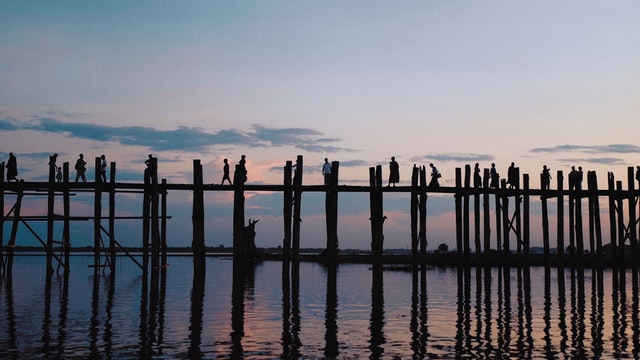 This is believed to be the oldest and the longest teakwood bridge in the world spanning 1.2km in length with 1,086 teak wood pillars. U Bein bridge was named after Mayor U Bein who built it in 1860 from recycling teak planks and columns from his former royal place. True beauty of the bridge lies in the traditional way it is used by the local community. Enjoy the serenity of monks dressed in their saffron robes peacefully walking or riding their bicycles along the bridge or the fishermen patiently fishing off the bridge’s vantage point. The spectacular sunsets from the U Bein bridge is a particular highlight where you get a picture-perfect scenery.
This is believed to be the oldest and the longest teakwood bridge in the world spanning 1.2km in length with 1,086 teak wood pillars. U Bein bridge was named after Mayor U Bein who built it in 1860 from recycling teak planks and columns from his former royal place. True beauty of the bridge lies in the traditional way it is used by the local community. Enjoy the serenity of monks dressed in their saffron robes peacefully walking or riding their bicycles along the bridge or the fishermen patiently fishing off the bridge’s vantage point. The spectacular sunsets from the U Bein bridge is a particular highlight where you get a picture-perfect scenery.
SAGAING REGION
-
Mingun Pagoda (Mingun)
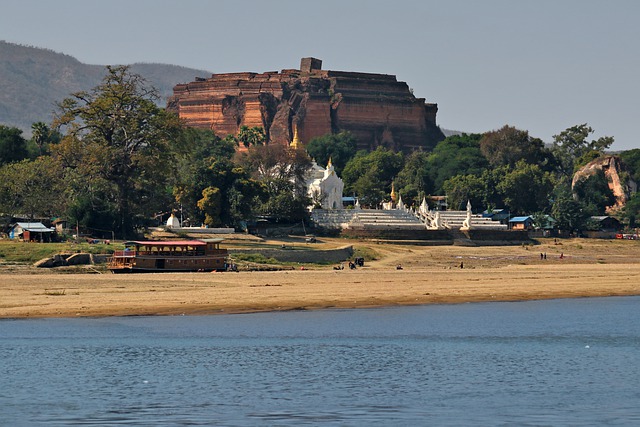 Located approximately 11 km from Mandalay, Mingun pagoda can be reached by ferryboats across the river. The trip takes 1 hour upstream and 40 minutes downstream. From the pier you can either walk to the pagoda or take an ox cart ride. As you approach the pagoda, you will be greeted by the remnants of two giant lion statues approximately 29 metres in high, guarding the temple’s entrance. The pagoda was built by King Bodawpaya during the 6th century. It is a largely unfinished structure due to technical difficulties with its construction and only reached a height of 50 metres (a third of its’ intended size).
Located approximately 11 km from Mandalay, Mingun pagoda can be reached by ferryboats across the river. The trip takes 1 hour upstream and 40 minutes downstream. From the pier you can either walk to the pagoda or take an ox cart ride. As you approach the pagoda, you will be greeted by the remnants of two giant lion statues approximately 29 metres in high, guarding the temple’s entrance. The pagoda was built by King Bodawpaya during the 6th century. It is a largely unfinished structure due to technical difficulties with its construction and only reached a height of 50 metres (a third of its’ intended size). -
Mingun Bell (Mingun)
 Be amazed by the enormity of the ringing bell! It is approximately 4 meters tall and weighs 90 tons. It is said the bell is the largest (or the second largest) working bell in the world.
Be amazed by the enormity of the ringing bell! It is approximately 4 meters tall and weighs 90 tons. It is said the bell is the largest (or the second largest) working bell in the world. -
Hsinbyume Pagoda (Mingun)
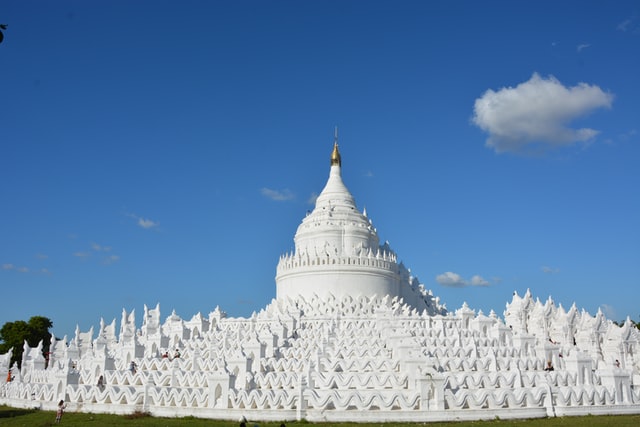 Hsinbyume Pagoda is a large pagoda located in the Sagaing Region, on the western bank of the Irrawaddy River. It is also within close proximity of the Mingun Pagoda. This impressive pagoda is painted in white, reflecting the physical description of the Buddhist mythological mountain, Mount Meru. The pagoda consists of seven circular terraces which represent the seven mountains which rise up to Mount Meru. All of the mythical creatures are depicted in the niches of the shrine including Ogres, Serpents, Nagas, the Nats and the Spirits.
Hsinbyume Pagoda is a large pagoda located in the Sagaing Region, on the western bank of the Irrawaddy River. It is also within close proximity of the Mingun Pagoda. This impressive pagoda is painted in white, reflecting the physical description of the Buddhist mythological mountain, Mount Meru. The pagoda consists of seven circular terraces which represent the seven mountains which rise up to Mount Meru. All of the mythical creatures are depicted in the niches of the shrine including Ogres, Serpents, Nagas, the Nats and the Spirits.
SHAN STATE
-
Kalaw Trek (Kalaw)
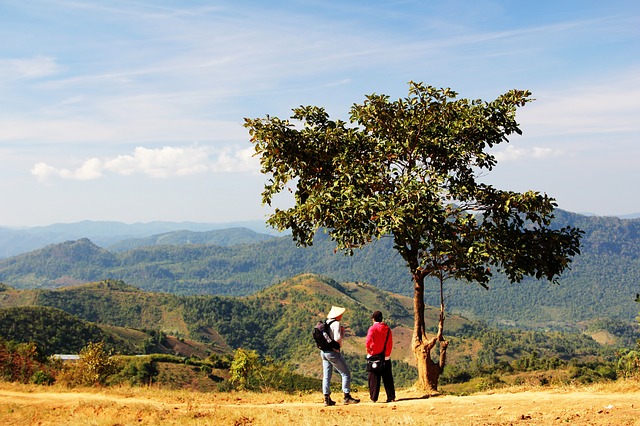 This is a popular trek amongst the adventure seekers and those that enjoy immersing themselves amongst nature. There are flexible options ranging from day treks to overnight treks to suit all abilities. Your experienced guide will take you on an adventure through the beauty of Shan State. During the trek, you will pass through amazing views of the sweeping mountains and hills, beautiful villages, farms, paddies fields and farm animals. You will also have the opportunity to enter the tiny villages where the locals greet you with warm hearts and a smile. Watch the local farmers planting and harvesting their crops. You will enjoy a home cooked meal from the locals in their home or a monastery. If you are to choose a longer overnight trek, you get the opportunity to stay in the home of a local village or a monastery.
This is a popular trek amongst the adventure seekers and those that enjoy immersing themselves amongst nature. There are flexible options ranging from day treks to overnight treks to suit all abilities. Your experienced guide will take you on an adventure through the beauty of Shan State. During the trek, you will pass through amazing views of the sweeping mountains and hills, beautiful villages, farms, paddies fields and farm animals. You will also have the opportunity to enter the tiny villages where the locals greet you with warm hearts and a smile. Watch the local farmers planting and harvesting their crops. You will enjoy a home cooked meal from the locals in their home or a monastery. If you are to choose a longer overnight trek, you get the opportunity to stay in the home of a local village or a monastery. -
Pindaya Caves (Pindaya)
 Also known as Buddha Caves, Pindaya Caves is located in the foothills of Shan State near Pindaya. Of the three major caves at Pindaya, only the southernmost cave can be accessed by the public. The Shwe U Min Paya is enshrined with approximately 8,000 images of Buddha. They were mindfully placed in the cave during the late 18th and early 19th centuries and is considered as being the most consistent collection of Buddhist iconography during this period in the whole of Myanmar (Burma).
Also known as Buddha Caves, Pindaya Caves is located in the foothills of Shan State near Pindaya. Of the three major caves at Pindaya, only the southernmost cave can be accessed by the public. The Shwe U Min Paya is enshrined with approximately 8,000 images of Buddha. They were mindfully placed in the cave during the late 18th and early 19th centuries and is considered as being the most consistent collection of Buddhist iconography during this period in the whole of Myanmar (Burma). -
5 Day Market (Inle Lake Area)
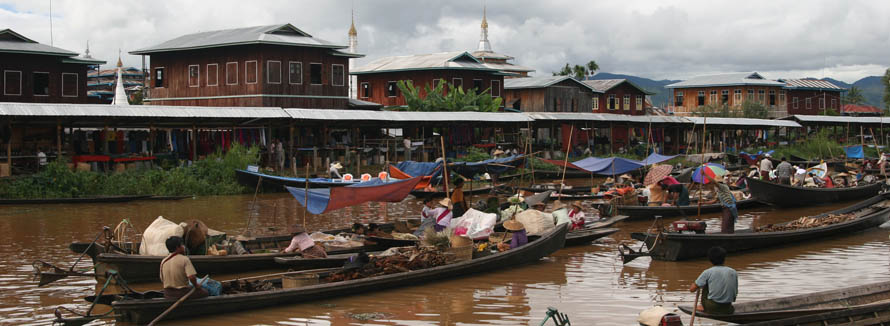 The 5-day market is a popular attraction during your visit to Inle Lake. It is a rotating market that is hosted in five different locations by different local hill tribes in the area. These areas include Ywama Village - the largest village on the Inle Lake, Phaung Daw U Pagoda - one of the famous principal shrines in Myanmar, Indein - one of the smaller villages of Inle Lake, Mine Thauk Marker - a large and bustling market, Nga Phe Kyaung Monastery - an attractive wooden monastery. The 5-day market is a hub for the local tribes to sell their produce and other items such as fresh vegetables and lacquer ware, Buddha statues, longyis and Shan bags to name a few. Enjoy interacting with the local tribes and observe the organised chaos as many locals flock to the markets by boat to buy items.
The 5-day market is a popular attraction during your visit to Inle Lake. It is a rotating market that is hosted in five different locations by different local hill tribes in the area. These areas include Ywama Village - the largest village on the Inle Lake, Phaung Daw U Pagoda - one of the famous principal shrines in Myanmar, Indein - one of the smaller villages of Inle Lake, Mine Thauk Marker - a large and bustling market, Nga Phe Kyaung Monastery - an attractive wooden monastery. The 5-day market is a hub for the local tribes to sell their produce and other items such as fresh vegetables and lacquer ware, Buddha statues, longyis and Shan bags to name a few. Enjoy interacting with the local tribes and observe the organised chaos as many locals flock to the markets by boat to buy items. -
Nga Phe Chaung Monastery (Inle Lake)
 Nga Phe Chaung Monastery is the largest and the oldest monastery on Inle Lake and was built in the late 1850‘s. It houses a large collection of Buddha images, each displayed on an elaborate pedestal. The images are in a variety of styles, including Shan, Bagan, Inwa and Tibetan, all clustered in the center of the monastery, supported by beautiful teak pillars. This monastery is also famous for its “jumping cats” which have been trained by the monks to perform for tourists by jumping through hoops. The cats are cared for by the monks and are housed within the vicinity of the monastery.
Nga Phe Chaung Monastery is the largest and the oldest monastery on Inle Lake and was built in the late 1850‘s. It houses a large collection of Buddha images, each displayed on an elaborate pedestal. The images are in a variety of styles, including Shan, Bagan, Inwa and Tibetan, all clustered in the center of the monastery, supported by beautiful teak pillars. This monastery is also famous for its “jumping cats” which have been trained by the monks to perform for tourists by jumping through hoops. The cats are cared for by the monks and are housed within the vicinity of the monastery. -
Phaung Daw Oo Pagoda (Inle Lake)
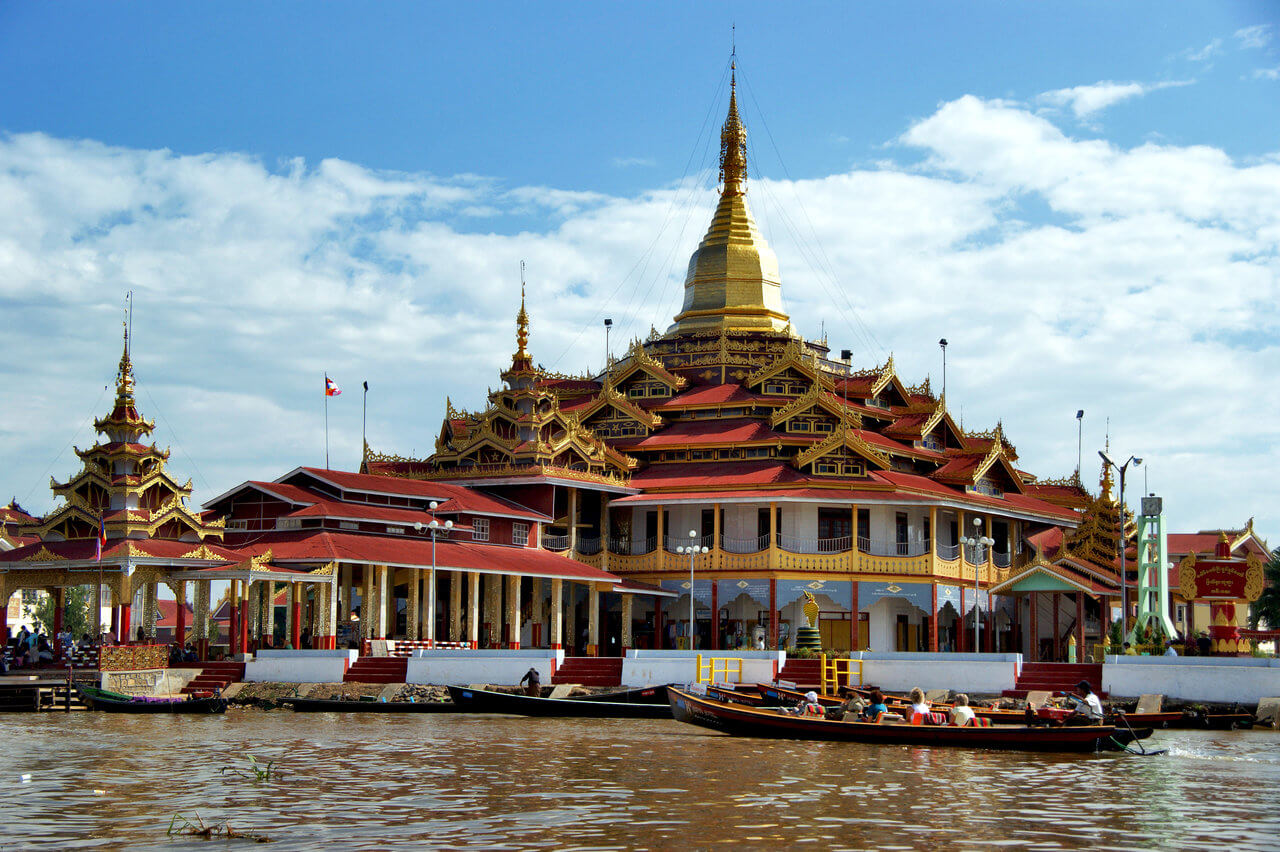 Phaung Daw Oo Pagoda is a prominent religious site on Inle Lake and is home to five small heavily gold-plated Buddha images. The main highlight of the Phaung Daw Oo Pagoda is the festival in honour of the Buddha statues. The annual celebration is determined by the Lunar calendar and is generally held between 10-27 October. During the festival, four of the Buddha statues are placed on an adorned royal barge and taken around the lake to different villages, for locals to pay their respects. Boat races around Inle Lake during the festival is a sight to see as the locals and tourists gather around Inle Lake to celebrate and enjoy the activities.
Phaung Daw Oo Pagoda is a prominent religious site on Inle Lake and is home to five small heavily gold-plated Buddha images. The main highlight of the Phaung Daw Oo Pagoda is the festival in honour of the Buddha statues. The annual celebration is determined by the Lunar calendar and is generally held between 10-27 October. During the festival, four of the Buddha statues are placed on an adorned royal barge and taken around the lake to different villages, for locals to pay their respects. Boat races around Inle Lake during the festival is a sight to see as the locals and tourists gather around Inle Lake to celebrate and enjoy the activities. -
Indein Village (Inle Lake)
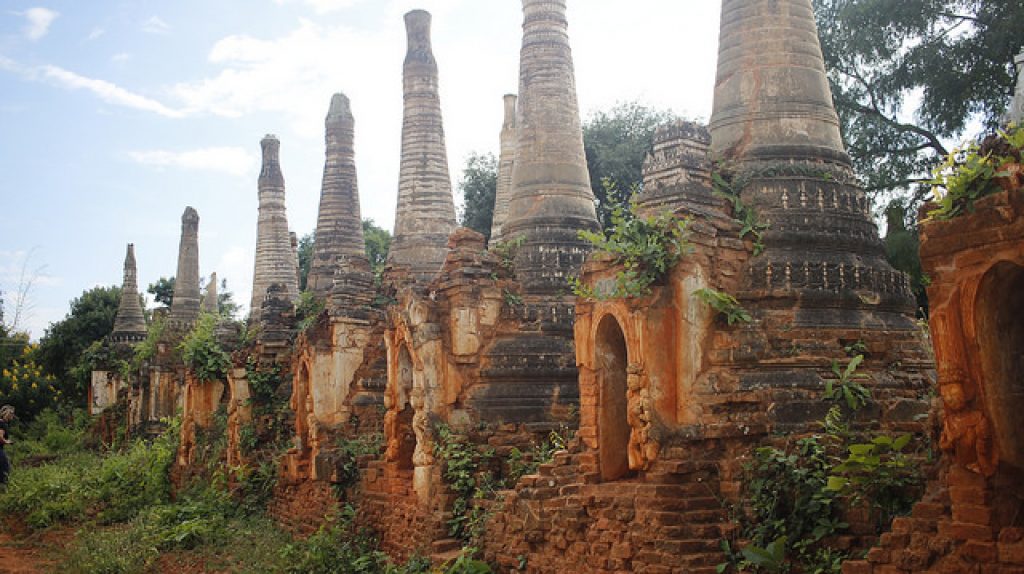 Indein is a small village located West of Inle lake. It is well-known for hosting the popular “5-day market” and two groups of ancient pagodas. The market is held in a five-day rotating cycle in five villages around the lake. It supports the Pa-Oh people who live in the surrounding area to sell their home-grown crops. It is also home to an extraordinary complex of stunning ancient pagodas that vary in size and shape. Some of the pagodas haven been restored throughout history and many pagodas still exist in their original state. Indein village can be reached by a scenic boat ride (approximately 8 kilometers) through Inn Thein creek.
Indein is a small village located West of Inle lake. It is well-known for hosting the popular “5-day market” and two groups of ancient pagodas. The market is held in a five-day rotating cycle in five villages around the lake. It supports the Pa-Oh people who live in the surrounding area to sell their home-grown crops. It is also home to an extraordinary complex of stunning ancient pagodas that vary in size and shape. Some of the pagodas haven been restored throughout history and many pagodas still exist in their original state. Indein village can be reached by a scenic boat ride (approximately 8 kilometers) through Inn Thein creek. -
Inthar Fishermen (Inle Lake)
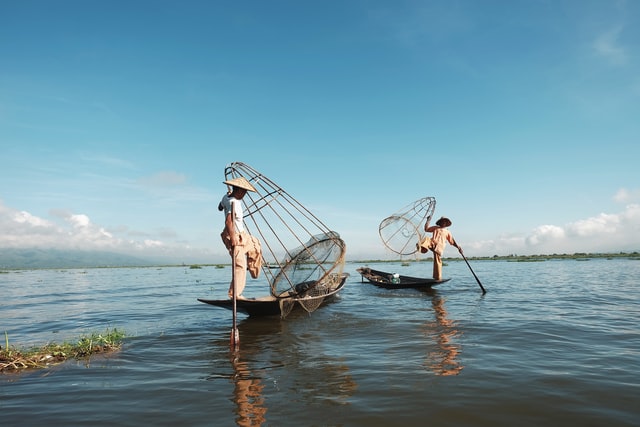 Be marvelled by the sheer and unique skills of these fishermen. While one of their legs balances the boat, the other leg is supporting the fishing cage, with one arm to steer and the other to aim the fishing cage. Taught from a young age, the local fishermen make it look so simple however much practice and concentration is required to master this unique technique.
Be marvelled by the sheer and unique skills of these fishermen. While one of their legs balances the boat, the other leg is supporting the fishing cage, with one arm to steer and the other to aim the fishing cage. Taught from a young age, the local fishermen make it look so simple however much practice and concentration is required to master this unique technique.
KAYIN STATE
-
Lumbini Garden (Hpa-An)
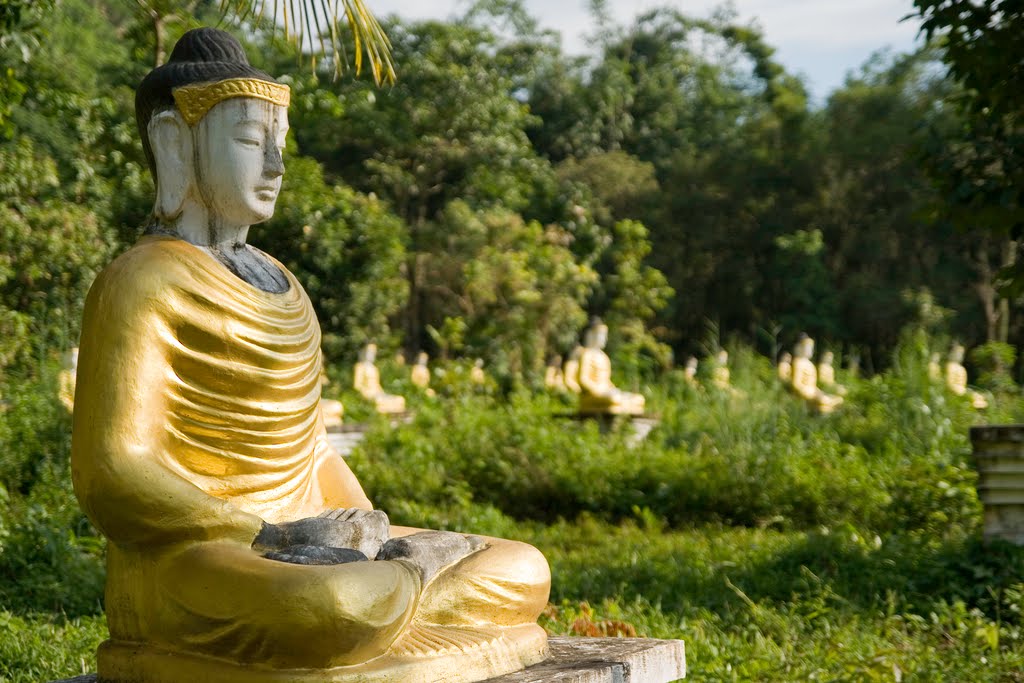 Lumbini Garden is home to over 1,100 Buddha statues dressed in beautiful golden robes. All statues are believed to be identical and perfectly aligned. It is a great location for that ideal postcard photo moment with the beauty of Mount Zwegabin sweeping the background.
Lumbini Garden is home to over 1,100 Buddha statues dressed in beautiful golden robes. All statues are believed to be identical and perfectly aligned. It is a great location for that ideal postcard photo moment with the beauty of Mount Zwegabin sweeping the background. -
Mount Zwegabin Climb (Hpa-An)
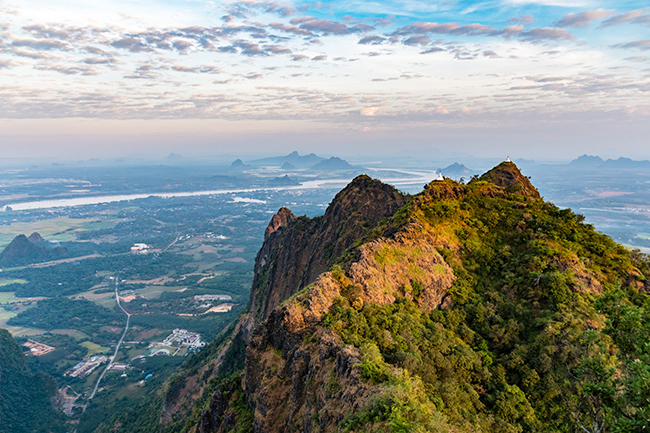 Mount Zwegabin is 772m tall and dominates with its beauty the backgrounds of Hpa An and it’s surrounds. This extraordinary limestone mountain is also home to Zwe Ka Bin Pagoda. Perched at the top of the mountain, Zwe Ka Bin Pagoda offers breathtaking views over Hpa An. Many travellers climb up the mountain for the amazing views. Whole experience can take approximately 3 hours (2 hours to reach the pagoda and 1 hour to descend). It is recommended to start the climb very early morning (approx. 4am) to avoid the heat and make it up in time for the majestic sunrise and magnificent views. The climb up the mountain can be very steep and you will need to pay extra attention to local monkeys along your way.
Mount Zwegabin is 772m tall and dominates with its beauty the backgrounds of Hpa An and it’s surrounds. This extraordinary limestone mountain is also home to Zwe Ka Bin Pagoda. Perched at the top of the mountain, Zwe Ka Bin Pagoda offers breathtaking views over Hpa An. Many travellers climb up the mountain for the amazing views. Whole experience can take approximately 3 hours (2 hours to reach the pagoda and 1 hour to descend). It is recommended to start the climb very early morning (approx. 4am) to avoid the heat and make it up in time for the majestic sunrise and magnificent views. The climb up the mountain can be very steep and you will need to pay extra attention to local monkeys along your way. -
Kyauk Ka lat Pagoda (Hpa-An)
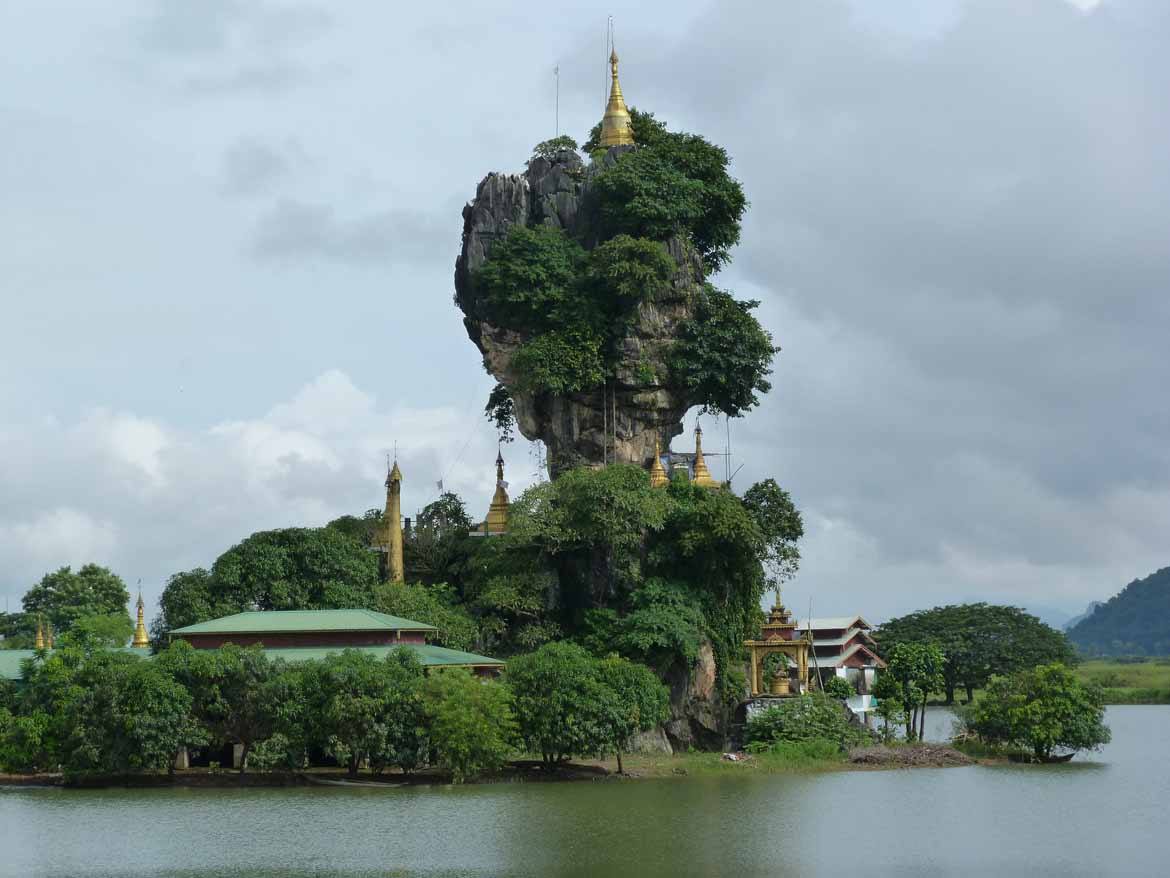 Located in the Kayin state, Kyauk Ka lat Pagoda is home to a community of monks. It is topped with a golden stupa and can be reached by a relaxing kayak ride. This Buddhist temple comprises of a series of structures, stupas and shrines, that is built on a prominent limestone rock formation and sits on a small island surrounded by a man-made lake. The very top part of the pagoda does not permit entry, however you can visit a shrine positioned midway up the rock for views of the area.
Located in the Kayin state, Kyauk Ka lat Pagoda is home to a community of monks. It is topped with a golden stupa and can be reached by a relaxing kayak ride. This Buddhist temple comprises of a series of structures, stupas and shrines, that is built on a prominent limestone rock formation and sits on a small island surrounded by a man-made lake. The very top part of the pagoda does not permit entry, however you can visit a shrine positioned midway up the rock for views of the area. -
Kaw Gun Cave (Hpa-An)
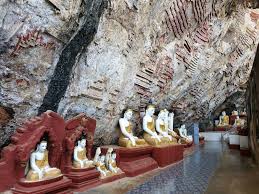 This marvellous cave is located 13 km from the town of Hpa An. It is recognised by the ethnic Mon as a sacred site of worship as it is believed that the cave was commissioned by a Mon Queen during the 7th Century.
This marvellous cave is located 13 km from the town of Hpa An. It is recognised by the ethnic Mon as a sacred site of worship as it is believed that the cave was commissioned by a Mon Queen during the 7th Century. -
Sadan Cave (Hpa-An)
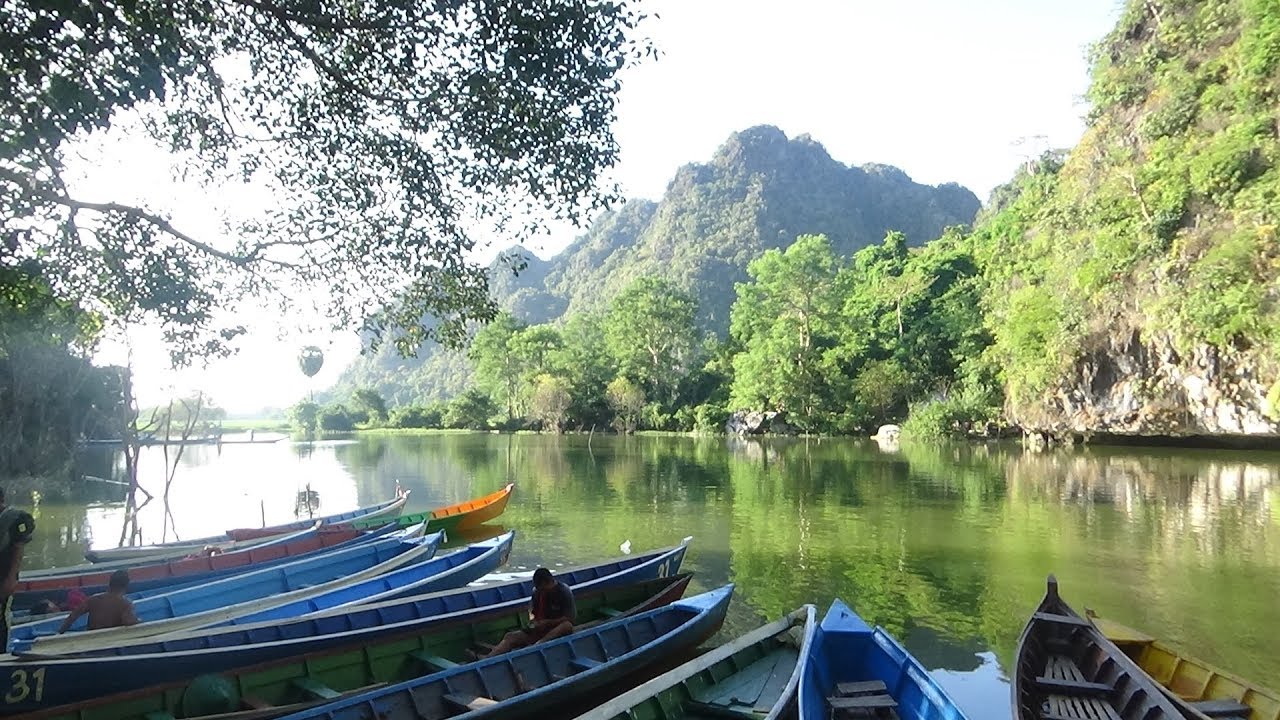 Sadan Cave is a spectacular natural wonder that greets its visitors with golden pagodas and Buddha statues at the entrance. It is said to be named after a scared elephant in history. Inside the cave you will discover remarkable natural beauty including gigantic chambers, stunning stalactites and spectacular crystal walls. Sadan Cave is a sacred site hence all visitors must enter the cave barefoot. Feel the cold and smooth surface of the pavement beneath your feet as you set to explore this magnificent beauty. Enjoy the spectacular sunrays glistening through the crevices of the cave and walk across the glittering lit suspension bridge. Once you reach the end of the cave, take a ride in a small colourful boat that will take you out of the cave and into the horizons where the tranquil blue seas harmoniously merge into the luscious green fields.
Sadan Cave is a spectacular natural wonder that greets its visitors with golden pagodas and Buddha statues at the entrance. It is said to be named after a scared elephant in history. Inside the cave you will discover remarkable natural beauty including gigantic chambers, stunning stalactites and spectacular crystal walls. Sadan Cave is a sacred site hence all visitors must enter the cave barefoot. Feel the cold and smooth surface of the pavement beneath your feet as you set to explore this magnificent beauty. Enjoy the spectacular sunrays glistening through the crevices of the cave and walk across the glittering lit suspension bridge. Once you reach the end of the cave, take a ride in a small colourful boat that will take you out of the cave and into the horizons where the tranquil blue seas harmoniously merge into the luscious green fields.
MON STATE
-
Kyaiktiyo Pagoda (Kyaiktiyo)
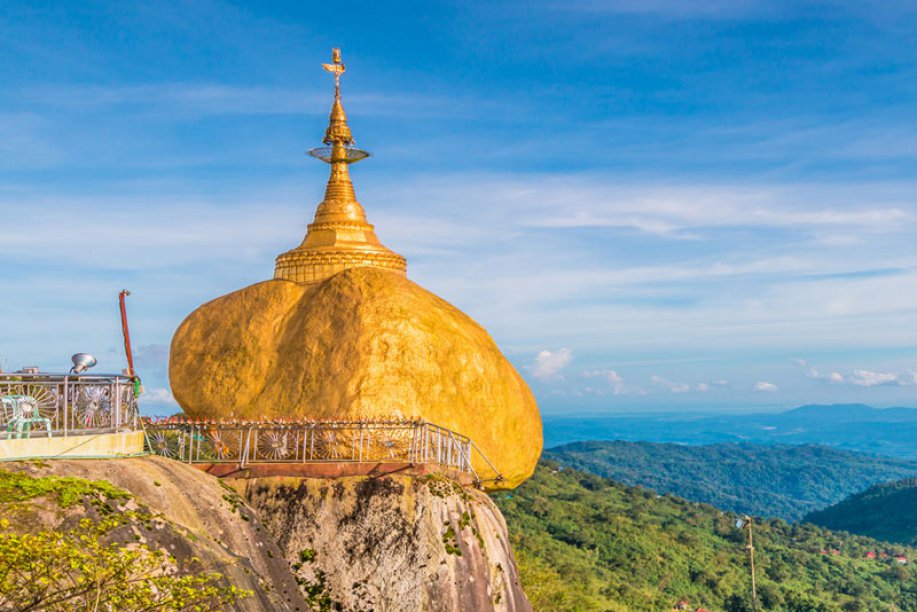 Kyaiktiyo Pagoda is a well-known Buddhist pilgrimage site in Mon State and its main attraction is the magnificent Golden Rock. It is a small pagoda (7.3 meters) built on the top of a granite boulder which is covered with gold leaves that have been pasted on by male devotees. According to legend, the Golden Rock itself is precariously perched on a single strand of the Buddha's hair. The Golden Rock is said to defy gravity, as it perpetually appears to be on the verge of rolling down the hill. The rock and the pagoda are scenically located at the top of Mt. Kyaiktiyo. Kyaiktiyo Pagoda is recognised as the third most important Buddhist pilgrimage site in Myanmar, after the Shwedagon Pagoda and the Mahamuni Pagoda. A glimpse of the "gravity defying" Golden Rock is truly a sight to remember.
Kyaiktiyo Pagoda is a well-known Buddhist pilgrimage site in Mon State and its main attraction is the magnificent Golden Rock. It is a small pagoda (7.3 meters) built on the top of a granite boulder which is covered with gold leaves that have been pasted on by male devotees. According to legend, the Golden Rock itself is precariously perched on a single strand of the Buddha's hair. The Golden Rock is said to defy gravity, as it perpetually appears to be on the verge of rolling down the hill. The rock and the pagoda are scenically located at the top of Mt. Kyaiktiyo. Kyaiktiyo Pagoda is recognised as the third most important Buddhist pilgrimage site in Myanmar, after the Shwedagon Pagoda and the Mahamuni Pagoda. A glimpse of the "gravity defying" Golden Rock is truly a sight to remember.
Myanmar remains one of the most majestic and spiritual destinations in Asia filled with temples, history, culture, beautiful scenery and authentic cuisine.
Also known as Burma, this remarkable country is bordered by China, Thailand, India, Laos and Bangladesh. Early civilization in Myanmar dates back to the 5th century and reached its peak of power and creativity between the 11th and 15th century. Myanmar is a unique destination that has stood still in time, untouched by the modern world.
Also known as Burma, this remarkable country is bordered by China, Thailand, India, Laos and Bangladesh. Early civilization in Myanmar dates back to the 5th century and reached its peak of power and creativity between the 11th and 15th century. Myanmar is a unique destination that has stood still in time, untouched by the modern world.
Do I need a visa to travel to Myanmar?
Please note Australian passport holders will need a visa to enter Myanmar. You can either apply at a Myanmar embassy/consulate in Australia OR via the convenient online option e-visa.
Below is the official government site to apply for e-visa.
E-visa is valid for 28 days and generally will be approved within 3 days of submission.
Please note visa is valid from 90 days from the issue date hence only apply within 3 months of travel.
Please take a copy of the approval and present at the Myanmar immigration upon arrival. Australian authorities may also request to check this. An electronic copy will be not sufficient hence please take a print out.
Is Myanmar safe to travel?
Main tourist areas such as Yangon, Bagan, Mandalay, Inle Lake is visited by foreigners and safe to travel. The Rakhine state southern part is not considered safe due to the ongoing conflict with Rohingyas. Some parts of Shan state (bordering Laos and China), Kachin state and Sagaing region bordering Bangladesh are off limits for travellers.
In 2010, Myanmar partially became democratic by holding elections. Since then, the tourist numbers have increased significantly to this untouched destination. The country has been marching towards democracy however recently in early 2021, the military government took over the power from the government. Military has declared they intend to rule for at least one year.
Always refer to the Australian traveller websites for up to date safety/security related information. e.g. https://www.smartraveller.gov.au/
What is the best time to travel?
Myanmar has 3 seasons. A rainy season (May to October), cool season (November to February) and a hot season (March to April). Best time to visit Myanmar is between the months of November and February when weather is cooler and stay dry. Temperature in highlands (e.g. Kalaw, Pindaya, Inle lake) can drops to 0c in the night during the months of December and January.
March and April are still good months to travel if you want to escape the crowds however temperatures can reach up to 40c in Yangon (In Bagan and Mandalay it may reach even higher).
During the wet season, months of July and August experience the highest rainfall.
 Accredited.
Accredited.
